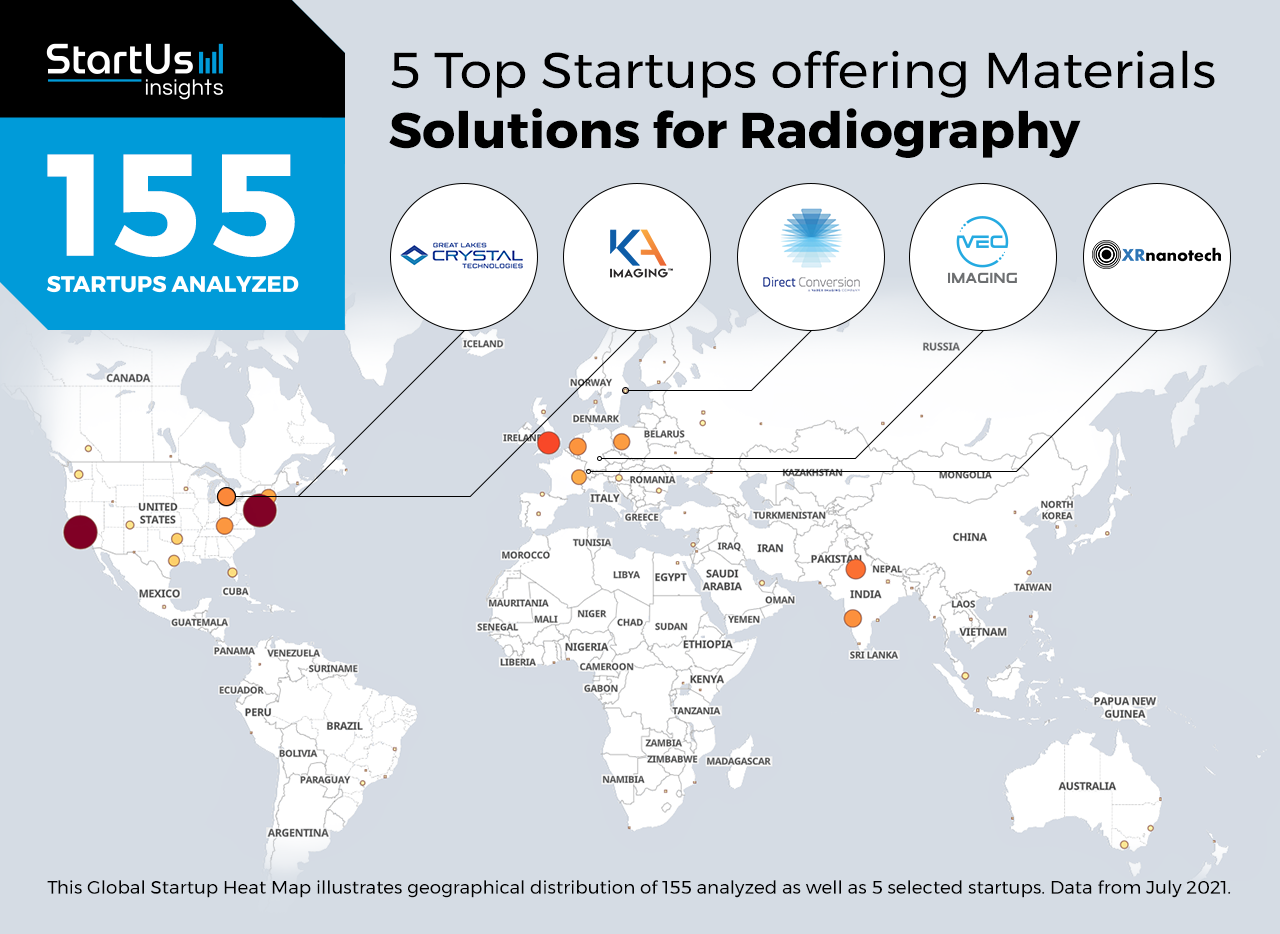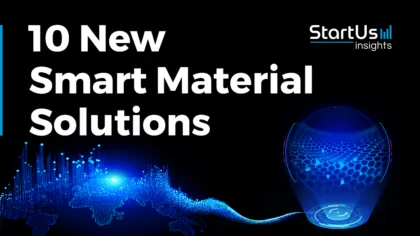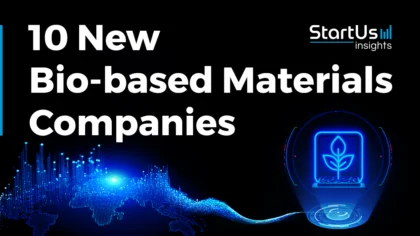Staying ahead of the technology curve means strengthening your competitive advantage. That is why we give you data-driven innovation insights into the materials industry. This time, you get to discover 5 hand-picked startups advancing materials for radiography.
Global Startup Heat Map highlights 5 Top Startups advancing Materials for Radiography out of 155
The insights of this data-driven analysis are derived from the Big Data & Artificial Intelligence-powered StartUs Insights Discovery Platform, covering 2.093.000+ startups & scaleups globally. The platform gives you an exhaustive overview of emerging technologies & relevant startups within a specific field in just a few clicks.
The Global Startup Heat Map below reveals the distribution of the 155 exemplary startups & scaleups we analyzed for this research. Further, it highlights 5 materials solutions for radiography developed by startups that we hand-picked based on criteria such as founding year, location, funding raised, and more. You get to explore the solutions of these 5 startups & scaleups in this report. For insights on the other 150 materials solutions for radiography, get in touch.
VEC Imaging builds Nanotube-based X-Ray Emitters
Conventional X-ray sources, like those used in computed tomography (CT) scanners, have remained almost unchanged since its invention a hundred years ago. The filament in this source must be heated to more than 800 degrees Celsius for the source to work. However, high filament temperatures require heat management, which additionally should be moved during operation. This takes a lot of space and makes the scanner very heavy, making CT devices as large as entire rooms. Startups develop new X-ray sources, which make CT scanners cheaper, smaller, and more efficient.
German startup VEC Imaging creates nanotube-based X-ray emitters. VEC Imaging’s emitter uses cold cathode instead of the traditional thermionic emitter. The cold cathode operates at room temperature and does not require additional cooling. Using nanotechnology, the startup integrates numerous nanotubes into a single vacuum tube. This, in turn, creates CT scanners without moving X-ray sources. Moreover, nanotube-based emitters drastically decrease the size of CT scanners, patient radiation dosage, and the total cost of ownership.
Great Lakes Crystal Technologies creates Diamond-based X-Ray Detectors
Diamond is a material with unique properties. Besides its high mechanical strengths, it finds applications in a broad range of electronic devices. It is also one of the most performant semiconductor materials. Additionally, its large bandgap, wide optical transmission window, high thermal conductivity, and stability make it ideal for radiation detection and x-ray diffraction optics. Startups work to solve the main problem of this technology, which is to utilize high-quality diamond crystals.
US-based startup Great Lakes Crystal Technologies creates a cost-effective source of high-performance diamond materials for advanced industrial applications. Great Lakes Crystal is developing ways to increase the sizes of diamond crystals without compromising on their quality. The startup’s diamonds find applications in high-performance electronics, quantum technologies, laser and X-ray diffraction optics, as well as deflectors.
Direct Conversion uses Cadmium Telluride for X-Ray Imaging
Traditional Complementary Metal Oxide Semiconductor (CMOS) X-ray detectors use scintillators – material that lightens when exposed to ionizing radiation to capture light by detecting photodiodes. Since using scintillators introduces scattering to the light, it results in an indistinct image. To overcome this issue, startups are developing technologies that replace scintillators for X-ray imaging.
Direct Conversion is a Swedish startup providing Cadmium Telluride CMOS X-ray imaging sensors. Their detectors do not utilize scintillators, which leads to removal of smearing or blurring, resulting in improved resolution and contrast. Further, Cadmium Telluride CMOS sensors provide a longer lifetime in comparison with scintillator-based sensors. As a result, the sensors do not degrade over time or lose image quality. Direct Conversions’ X-ray sensors are used in multiple industries, including medical, heavy industries, welding, food, and security.
XRnanotech develops Nanoscale X-Ray Optics
One important characteristic of X-ray is that it easily goes through most materials without interruption. Despite this, radiography solutions still lack the high-quality imaging that industries increasingly demand. That is why startups are working on the development of nanostructure technology to achieve novel ways to improve X-ray quality.
XRnanotech is a startup from Switzerland creating high-quality X-ray optics using custom 3D-nanostructures and ultra-stable diamond optics. Their manufacturing processes utilize a range of materials including gold, diamond, nickel, silicon dioxide, iridium, and chromium to create specific material properties. Further, XRnanotech’s line-doubling technique achieves an X-ray beam focus as precise as 5 nanometers, allowing the creation of high-resolution images for radiography. Some applications of the solution include creating Fresnel-zone plates and custom design optics for cameras, detectors, and general scientific use.
KA Imaging offers Amorphous Selenium (a-Se) X-Ray Cameras
X-ray radiation has a destructive effect on some materials, like organic tissues or materials with complex molecular structures. Scanning low-dense materials using X-ray is also very complicated due to its high-penetration properties. Startups develop solutions that eliminate the process of thinning the conversion layer to minimize optical scatter, as are current indirect scintillator-based approaches. These approaches allow for highly accurate X-ray imaging applications as well as scientific research.
Canadian startup KA Imaging offers a patented amorphous selenium (a-Se) X-ray camera, BrillianSe, for high-quality imaging. BrillianSe provides a combination of high spatial resolution using small pixel size, and high Detective Quantum Efficiency (DQE) for energies up to 110 keV (electronvolt). This combination enables efficient throughput-limited imaging at low flux and high energy, as well as a propagation-based in-line phase-contrast enhancement. This results in improved sensitivity, especially when imaging low-density materials. KA Imaging’s X-ray cameras are useful in the medical and pharma industries as well as for material research.
Discover more Materials Startups
Materials startups such as the examples highlighted in this report focus on radiography solutions that utilize novel materials including diamonds, cadmium telluride, and selenium as well as nanotechnology improvements. While all of these technologies play a major role in advancing the materials industry, they only represent the tip of the iceberg. To explore more materials technologies, simply get in touch to let us look into your areas of interest. For a more general overview, you can download our free Materials Innovation Report to save your time and improve strategic decision-making.







